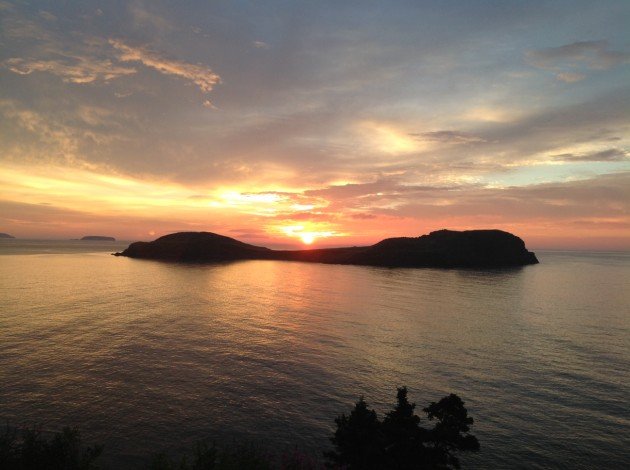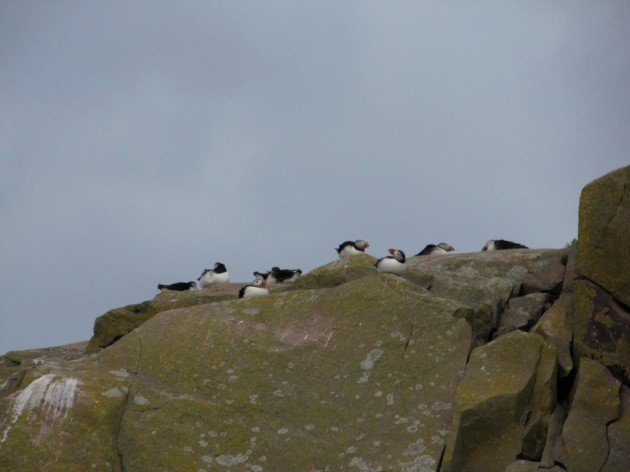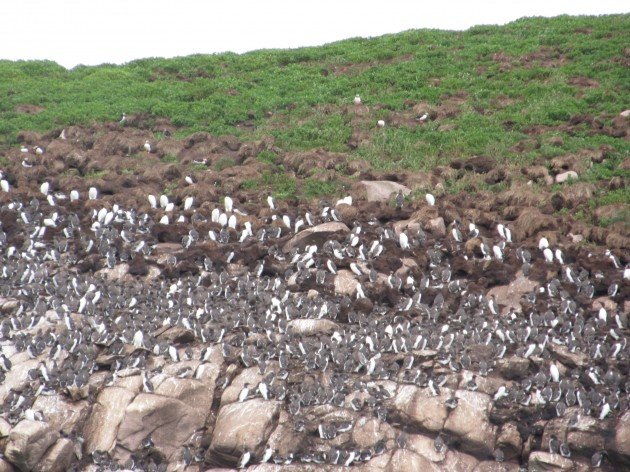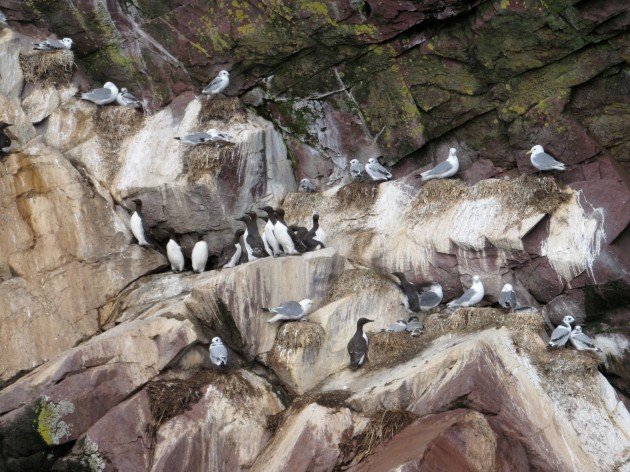
Julia Zarankin is on her way to becoming a birder. In her other life, she is a writer, editor, writing coach, and lecturer to later-life learners in Toronto. In her former life, she worked as a professor of Russian literature and culture at the University of Missouri. She contributes regularly to Ontario Nature, reviews books for Birding, and also blogs about her misadventures in bird identification while offering trenchant analysis of avian coiffures on her own blog Birds and Words. This is Julia’s first contribution to 10,000 Birds.
Before my trip to Newfoundland in mid-August, I honestly believed that a gull was just a gull. The inscrutable species frustrated me and I found myself especially stumped by the difficulty I had distinguishing them, and wildly mystified by the excitement they inspired in my fellow-birders. I knew that the east coast of Newfoundland would charm me with its hundreds of thousands of Atlantic Puffins – since it is, after all, home to the largest Puffin colony in North America – but I had no idea that the gulls would be the ones to leave a lasting mark on me.
Our bird sightings began immediately, as soon as we checked into our B&B, located on a cliff overlooking the Witless Bay Ecological Reserve, on the Avalon Peninsula of Newfoundland. About 35 miles south of St. John’s, in the minuscule community of Bauline East (and I do mean minuscule – there were about fifteen houses in total), Whalewatcher B&B delighted us. When it wasn’t raining, we spent much of our afternoons on deck, mesmerized by the dozens of puffins scurrying about restlessly, flapping their wings furiously just above the water. We didn’t even need binoculars to enjoy the puffins – they were close enough to be marveled at naked-eye! Every so often, a Northern Gannet would punctuate the serenity by dive-bombing into the water, headfirst like a bullet. He must have been after capelin. Sea otters put on a playful dance show for us, and proceeded to laze about on the rocks, which we interpreted as posing for the camera.
I knew there were hundreds of gulls circling above because I could hear their riotous creaking sounds, but I didn’t pay attention beyond identifying them Herring gulls. And then, out of nowhere, an enormous, glistening Great Black-backed Gull glided into my field of vision, dipped down to retrieve his lunch just below the surface of the water, and soared off. This was a lifer for me and I was smitten – not so much by the seabird’s awesome wingspan, or the shiny blackness of its back, but by its majestic confidence as it cut through the air. A regal, intrepid wonder of a bird and I surprised myself by forgiving the black-backed gull for terrorizing (and consuming) puffins, grebes, and numerous other sea bird species.
We later signed up for a whale and birdwatching tour with Captain Wayne, who had a smallish 12-person boat. With the winds higher than usual, it turned out we were Captain Wayne’s only passengers, so we lucked into a private tour of the Witless Bay Ecological Reserve. (Captain Wayne warned us that we might get wet, but after hiking through pouring rain for two days, a few ocean sprays did nothing to dissuade us.) Though the views from the B&B had been spectacular, nothing compares to seeing seabirds from the water. An auspicious Bald Eagle sighting – positioned high in a pine tree – heralded the beginning of a magical afternoon, where we sailed amidst over a million breeding seabirds. On our way to the breeding rocks, we saw a group of Ruddy Turnstones fly off, but they turned a corner before we could get acquainted properly.
And then, as soon as we headed toward the open ocean, hundreds of Atlantic Puffins and Common Murres crisscrossed the air, flying haphazardly, using their wings as high-powered propellers (many of them flying sideways due to high winds). Watching the birds in action felt like playing a video game, where your field of vision is constantly pelted by flying objects. A lone Greater Shearwater flew in front of us gallantly, entirely unfazed by the wind.
When we reached Gull Island – one of the four islands comprising the ecological reserve – we had no more use for our binoculars: thousands of breeding puffins were hanging out at their nests in burrows along the vertical cliff side. Thousands of Common Murres congregated above the puffin territory, since they nest in rock shelves along the cliffs. I had never noticed how penguinesque these murres look, especially when they’re standing upright, exposing their white underside.
Standing next to an enormous group of murres, I caught sight of a lone Razorbill, entrancing in its elegance. (Alas, he greeted us by relieving himself in a most ungentlemanly fashion, but we forgave the tuxedoed wonder of a bird.) Interspersed among the puffins and murres, nesting on tiny outcrops of the cliff, we saw thousands of Black-legged Kittiwake, another lifer for me on this trip. I marveled at the Kittiwake’s wing-tips, which look like they’ve been outlined in black ink by a meticulous calligrapher. Not to mention the phenomenal gulls circling overhead. After a surfeit of stunning Auks, we had a hard time focusing our attention on the Humpback and Minke whales that regaled us with fabulous displays.
I had a hard time leaving the Witless Bay area, but managed to add eight seabirds to my life list. Apart from reinforcing my obsession and love for anything auk-like, who knew that I’d return home reinvigorated to learn more about gulls?

















Bird cliffs with their thousands of nesting seabirds, sounds, activity and smells are an incredible experience, aren’t they? Thanks for sharing your experience of Witless Bay. Does anyone know where the name comes from by the way? (I’m an Aussie so hadn’t heard of it before.)
Thanks for reading, Sonja! Legend has it that Witless bay was originally called Whittle’s Bay after Captain Whittle, who arrived from England and settled there. Later, after his death, his family moved back to England and the named morphed to Whittle-Less Bay. Still later, that turned into Witless Bay!
Thanks for a wonderful post! I enjoyed your writing and learning of the wonders you observed. Would love to go there one day!
The rumor is that it is a corruption of Whittle’s Bay.
Great report, Julia!
Nice story, good job maybe I will visit.